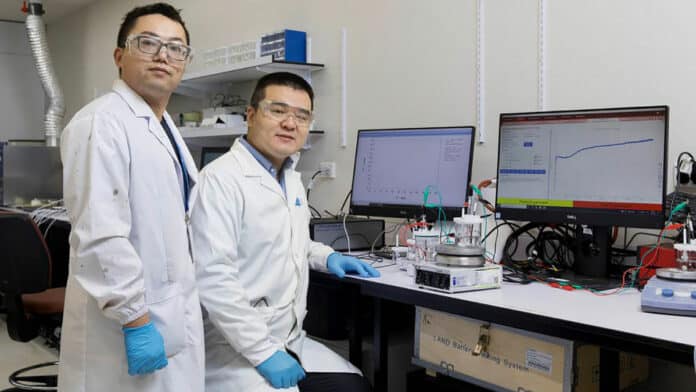One of the 21st century’s major challenges is mitigating the effects of climate change by reducing greenhouse gas emissions, especially carbon dioxide (CO2). One possible way to achieve this is to convert CO2 into useful chemicals that can be used as fuels, feedstocks, or materials.
Electrolysis has the potential to reduce carbon dioxide (CO2) into useful chemicals, which could contribute to a more sustainable and carbon-neutral future. However, this process is quite challenging to develop into a robust and efficient system, as it typically requires alkaline conditions that limit carbon utilization and system stability.
While some strategies, such as physical washing and pulsed operation, can help mitigate these problems, they have yet to fully resolve them.
In a new study, researchers at the University of Auckland have developed a method to convert waste carbon dioxide into a precursor for chemicals and carbon-free fuel for use in various applications. This groundbreaking research paves the way for carbon-neutral technologies and a sustainable future.
The team led by Dr. Ziyun Wang from the School of Chemical Sciences, along with their Chinese colleagues, used a combination of computational chemistry and electrochemical experiments to demonstrate a method for turning CO2 into formic acid.
They used a catalyst made from waste lead-acid batteries, which enabled a transformation that was not previously possible with existing catalysts.
Formic acid is a colorless and pungent liquid with the potential as a transportation fuel for storing electrical energy and for reducing CO2 emissions in the petrochemical industry. With carbon dioxide emissions being a major contributor to global warming, scientists are exploring various options for capturing and storing CO2, repurposing it, and transitioning to a carbon-free economy.
“This innovation opens up exciting possibilities for carbon-neutral technologies,” he says. “In the future, cars and gas stations could be using repurposed carbon dioxide.”
The innovative method employs a proton exchange membrane electrolyzer, a device that effectively converts CO2 for over 5,000 hours. In a proton exchange membrane electrolyzer, carbon dioxide is fed into an electrochemical cell and transformed into formic acid, similar to charging a battery.
Scientists have calculated that the process can be scaled up for industrial use in a cost-effective manner. With possible applications in cars, gas stations, and the petrochemical industry, this technology could potentially help in the transition toward a carbon-free economy and reduce greenhouse gas emissions.
“The biggest challenge now is finding the financial support to further explore our technology’s possibilities,” says Wang.
Journal reference:
- Wensheng Fang, Wei Guo, Ruihu Lu, et al. Durable CO2 conversion in the proton-exchange membrane system. Nature, 2024; DOI: 10.1038/s41586-023-06917-5
